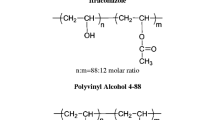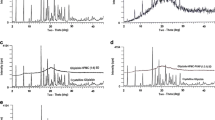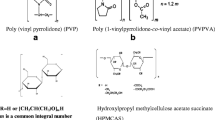No Heading
Purpose.
To determine the factors influencing “solid solubility” and phase separation kinetics of drugs from amorphous solid dispersions.
Methods.
Solid dispersions of griseofulvin-poly(vinyl pyrrolidone) (PVP) and indoprofen-PVP were prepared using solvent evaporation technique. Dispersions demonstrating single Tg were exposed to 40°C/69% RH for 90 days. Drug solid solubility in the polymer and phase separation rates were determined from changes in Tg of solid dispersions. FTIR spectroscopy and XRD were used to characterize drug-polymer interactions and drug crystallinity, respectively.
Results.
Freshly prepared solid dispersion of up to 30% w/w griseofulvin and indoprofen were molecularly miscible with PVP. Hydrogen bonding was evident in indoprofen-PVP, but not in griseofulvin-PVP dispersions. When exposed to 40°C/69% RH, griseofulvin phase separated completely, whereas the solid solubility of indoprofen was determined as 13% w/w. The first-order rate constants of phase separation for 10%. 20%, and 30% w/w griseofulvin dispersions were estimated as 4.66, 5.19, and 12.50 (×102) [day−1], and those of 20% and 30% w/w indoprofen were 0.62 and 1.25 (×102) [day−1], respectively.
Conclusions.
Solid solubility of griseofulvin and indoprofen in PVP is ∼0% w/w and ∼13% w/w, respectively. Drug-polymer hydrogen bonding in indoprofen-PVP dispersions favors solid solubility. Phase separation rate of drug from the solid dispersions depends on the initial drug content and the nature of drug-polymer interactions.
Similar content being viewed by others
References
1. K. Sekiguchi and N. Obi. Studies on absorption of eutectic mixture. I. A comparision of the behavior of eutectic mixture of sulfathiazole and that of ordinary sulfathiazole in man. Chem. Pharm. Bull. (Tokyo) 9:866–872 (1961).
2. R. M. Dannenfelser, H. He, Y. Joshi, S. Bateman, and A. T. M. Serajuddin. Development of clinical dosage forms of a poorly water soluble drug I: application of polyethylene glycol-polysorbate 80 solid dispersion carrier system. J. Pharm. Sci. 93:1165–1175 (2004).
3. D. Q. M. Craig. The mechanisms of drug release from solid dispersions in water-soluble polymers. Int. J. Pharm. 231:131–144 (2002).
4. J. Breitenbach, G. Berndl, J. Neumann, J. Rosenberg, D. Simon, and J. D. Zeidler. Solid dispersions by an integrated melt extrusion system. Proc. Control. Rel. Soc. 25:804–805 (1998).
5. S. Sethia and E. Squillante. Physicochemical characterization of solid dispersions of carbamazepine formulated by supercritical carbon dioxide and conventional solvent evaporation method. J. Pharm. Sci. 91:1948–1957 (2002).
6. A. H. Forester, J. Hempenstall, and T. Rades. Characterization of glass solutions of poorly water-soluble drugs produced by melt extrusion with hydrophilic amorphous polymers. J. Pharm. Pharmacol. 53:303–315 (2001).
7. K. Kimura, F. Hirayama, H. Arima, and K. Uekama. Effects of aging on the crystallization, dissolution and absorption characteristics of an amorphous tolbutamide/2-hydroxypropyl-beta-cyclodextrin complex. Chem. Pharm. Bull. (Tokyo) 48:646–650 (2000).
8. W. L. Chiou. Pharmaceutical applications of solid dispersion systems: X-ray diffraction and aqueous solubility studies on griseofulvin-poly(ethylene glycol) 6000 systems. J. Pharm. Sci. 66:989–991 (1977).
9. H. Suzuki and H. Sunada. Some factors influencing the dissolution of solid dispersions with nicotinamide and hydroxypropylmethylcellulose as combined carriers. Chem. Pharm. Bull. (Tokyo) 46:1015–1020 (1998).
10. H. Imaizumi, N. Nambu, and T. Nagai. Stabilization of amorphous state of indomethacin by solid dispersion in polyvinylpyrrolidone. Chem. Pharm. Bull. (Tokyo) 31:2510–2512 (1983).
11. K. Khougaz and S. Clas. Crystallization inhibition in solid dispersions of MK-0591 and poly(vinylpyrrolidone) polymers. J. Pharm. Sci. 89:1325–1334 (2000).
12. T. Matsumoto and G. Zografi. Physical properties of solid molecular dispersions of indomethacin with poly(vinylpyrrolidone) and poly(vinylpyrrolidone-co-vinyl-acetate) in relation to indomethacin crystallization. Pharm. Res. 16:1722–1728 (1999).
13. B. C. Hancock and G. Zografi. The relationship between the glass transition temperature and the water content of amorphous pharmaceutical solids. Pharm. Res. 11:471–477 (1994).
14. C. A. Okasen and G. Zografi. Molecular mobility in mixtures of absorbed water and solid poly(vinylpyrrolidone). Pharm. Res. 10:791–799 (1993).
15. M. Vasanthavada, W. Tong, Y. Joshi, and M. S. Kislalioglu. Phase behavior of amorphous molecular dispersions I: determination of the degree and mechanism of solid solubility. Pharm. Res. 9:1598–1606 (2004).
16. H. Nyqvist. Saturated salt solutions for maintaining specified relative humidities. Int. J. Pharm. Tech. & Prod. Mfr. 4:47–48 (1983).
17. L. S. Taylor and G. Zografi. Spectroscopic characterization of interactions between PVP and indomethacin in amorphous molecular dispersions. Pharm. Res. 14:1691–1698 (1997).
18. K. Six, H. Berghmans, C. Leuner, J. Dressman, K. V. Werde, J. Mullens, L. Benoist, M. Thimon, L. Meublat, G. Verreck, J. Peeters, M. Brewster, and G. V. Mooter. Characterization of solid dispersions of itraconazole and hydroxypropylmethylcellulose prepared by melt extrusion, part II. Pharm. Res. 20:1047–1054 (2003).
19. C. Doherty and P. York. Accelerated stability of an X-ray amorphous frusemide-polyvinylpyrrolidone solid dispersion. Drug Dev. Ind. Pharm. 15:1969–1987 (1989).
20. K. J. Crowley and G. Zografi. The effect of low concentrations of molecularly dispersed poly(vinylpyrrolidone) on indomethacin crystallization from the amorphous state. Pharm. Res. 20:1417–1422 (2003).
21. R. Boistelle and J. P. Astier. Crystallization mechanisms in solution. J. Cryst. Growth 90:14–30 (1988).
Author information
Authors and Affiliations
Corresponding author
Rights and permissions
About this article
Cite this article
Vasanthavada, M., Tong, WQ., Joshi, Y. et al. Phase Behavior of Amorphous Molecular Dispersions II: Role of Hydrogen Bonding in Solid Solubility and Phase Separation Kinetics. Pharm Res 22, 440–448 (2005). https://doi.org/10.1007/s11095-004-1882-y
Received:
Accepted:
Published:
Issue Date:
DOI: https://doi.org/10.1007/s11095-004-1882-y




